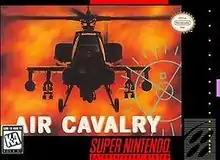Air Cavalry (video game)
Air Cavalry is a flight simulation video game developed by Synergistic Software. It was released by Cybersoft and GameTek for the Super NES in 1995.
| Air Cavalry | |
|---|---|
 North American cover art | |
| Developer(s) | Synergistic Software |
| Publisher(s) | |
| Programmer(s) | Alan Clarke Steve Coleman Christopher Phillips |
| Composer(s) | Christopher Barker Craig Utterback |
| Platform(s) | Super NES |
| Release | |
| Genre(s) | Flight simulation Shoot 'em up |
| Mode(s) | Single player 2-player competitive 2-player cooperative |
Gameplay
In the game, players control an advanced helicopter gunship. Flying above multiple types of terrain, players have to complete a number of objectives using different types of helicopters with different uses for each. Players can select from three theatres of operations with six or more objectives that increase in difficulty. Players can also practice in the training mission.
Reception
| Publication | Score |
|---|---|
| EGM | 5.875 out of 10[1] |
| Next Generation |
The game received generally mixed reviews. The four reviewers of Electronic Gaming Monthly commented that the low supply of ammunition and the unfailing accuracy of enemy fire make the game unpleasantly difficult, and that the Mode 7 sequences look poor. They nonetheless assessed the game as "decent", and said that enthusiasts of military games would find it very appealing.[1] GamePro, in contrast, praised the Mode 7 sequences and remarked that "Easy targeting and non-moving enemies makes this a better game for rookies than veterans." While they criticized the slow-moving helicopter and simplistic gameplay compared to the Strike series, they concluded that "if you're looking for a solid shooter, Air Cavalry comes to the rescue."[3]
Next Generation reviewed the game, and stated that "Success is as much of luck as skill, which makes it frustrating as well as overly repetitive."[2]
References
- "Review Crew: Air Cavalry". Electronic Gaming Monthly. Ziff Davis (71): 35. June 1995.
- "Finals". Next Generation. No. 5. Imagine Media. May 1995. p. 100.
- "ProReview: Air Cavalry". GamePro. IDG (82): 65. July 1995.
External links
- Air Cavalry game information at MobyGames